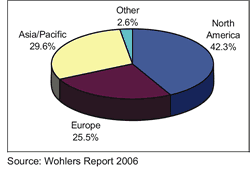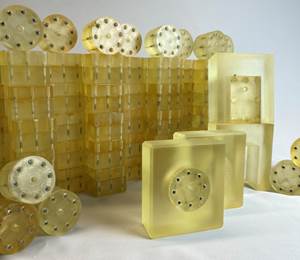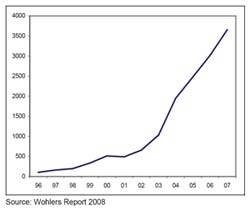Worldwide Review and Analysis Of Additive Fabrication
Additive fabrication technologies can save significant amounts of design and manufacturing time when used properly.
Additive fabrication refers to a group of technologies used for building physical models, prototypes, tooling components and finished series production parts—all from 3-D computer-aided design (CAD) data, CT or MRI scans, or data from 3-D scanning systems. Unlike machining processes, which are subtractive in nature, additive systems join together liquid, powder, or sheet materials to form parts. Parts that may be difficult or even impossible to manufacture by any other method can be produced by additive systems. Based on thin, horizontal cross sections taken from a 3-D computer model, they produce plastic, metal, ceramic or composite parts, layer upon layer.
Around the world, additive fabrication is changing the way organizations design and manufacture products. When used correctly, it can save impressive amounts of time and money. Companies maintain that additive processes have helped them trim weeks and even months of design, prototyping and manufacturing time, while enhancing the quality and range of their products. Bringing a product to market weeks or months before your competitors can mean the difference between success and failure. Companies that choose to apply additive technologies are able to compete more effectively.
After more than 15 years of research, development and use, the industry continues to grow with the addition of new technologies, methods and applications. Additive processes have had a tremendous impact on design and manufacturing, and will continue to expand over the coming years.
Industry Growth
The industry has remained solid after a spectacular 2004. Systems, materials and services experienced double-digit growth in 2005, although it was nothing like the previous year. Interest in 3-D printers continues to drive demand in the 70 countries in which systems were sold last year.
Years ago, the machine manufacturers felt little competitive pressure to lower prices. This is not true today. Over the past couple of years, prices have been forced downward, even as capabilities improve. As sales volumes swell, prices will drop further. This trend will increase further as companies such as Desktop Factory introduce 3-D printers in the $5,000 to $7,000 range.
Growing a large installed base is more important than ever as companies build businesses around recurring revenues from consumables. Also, the larger the customer base, the easier it is to sell future products and services. Recent sales activity by Stratasys and Z Corp. show that these two companies are currently leading the pack in achieving this objective.
The use of systems for rapid manufacturing also is gaining momentum. Successfully fabricating end-use parts is a much more demanding proposition than using 3-D printers for concept design and modeling, so it will require time to develop. Even so, rapid manufacturing has caught the attention of many and is expected to become the largest application of additive technology in the future.
The services segment of the industry remains healthy. In 2003, service providers experienced a moderate turnaround. In 2004, this segment mounted a very impressive comeback. Results from 2005 show that the companies in the services business have positioned themselves for sustained growth, which was quite uncertain prior to 2003.
The many ways in which manufacturing organizations are applying additive fabrication are capturing the attention of many groups. Investors, analysts and members of the press are taking note of the vast potential that additive processes have on product design and modeling, custom products and rapid manufacturing.
How Companies Are Applying Additive Processes
Chart 1 shows that fit and function applications continue to be a popular use of additive systems. This category—derived by combining the “functional models” and “fit and assembly” segments—represents 27.3%. Meanwhile, visual applications account for 26.3%.
Nearly one-third (29.5%) of customers use the parts for tooling- or pattern-related applications. The parts are used for prototype tooling and metal casting, as well as for tooling inserts. Meanwhile, rapid manufacturing continues to grow impressively, rising to 9.6% in 2006.
Activity Around the World
Chart 2 shows the percentage of systems installed in the major regions of the world. North America is home to more than 42% of the systems installed worldwide.
In 1997, North America accounted for 52.6% of the systems installed. Its share declined to 43.8% in the four years that followed, but has changed very little over the past four years. It is expected to slowly decline in the years to come, as China, India, and other developing countries modernize product development methods and embrace additive fabrication.
In 2005, the number of installations in the Asia/Pacific region grew by 12.1% to 975 machines. This is down from the 43% growth in 2004 and 22.7% growth in 2003. The cumulative installed base for the region now stands at 5,254 machines through the end of 2005. An estimated 29.6% of all machines were installed in this region at the end of 2005.
Additive processes are established at various levels in many countries in Europe. Organizations in these countries are conducting world-class research and development and using the technology for prototyping, tooling and manufacturing. Much collaboration between industry, academia, and local and national government is taking place. The experience and expertise from these projects is leading to new products and services.
Europe as a whole had a good 2005 as measured by new installations, although the region cooled some from its extraordinary growth of 2004. In 2005, the number of installations in Europe grew by 34.6%, compared to 95.2% the year before. Through the end of 2005, an estimated 3,455 machines were installed in Germany, France, Italy and the UK. This is up 26.2% from the end of 2004.
Countries that have historically installed few systems each year are beginning to purchase more substantial quantities. Most notable is South Africa with 24 new systems in 2005 and 15 in 2004. Previously, no more than two systems per year were sold and installed in the country.
3-D Printers
It is estimated that Stratasys, Z Corp., 3-D Systems, Objet Geometries, Envisiontec and Solidimension sold 3-D printers valued at $100.2 million in 2005. This is up 35.2% from the $74.1 million in 3-D printers sold in 2004, although down from the 99.5% growth in 2004.
In unit sales, most 3-D printer manufacturers had another solid year. Graph 1 shows the impressive growth in recent years. 3-D printers represent 44.3% of all additive systems installed worldwide through the end of 2005. This is up from 37.9% in 2004, 30.7% in 2003, and 25.8% in 2002.
Several indicators suggest strong growth for 3-D printers over the next several years. If the worldwide economy remains relatively strong, an estimated 15,000 3-D printers are expected to sell annually by 2010.
Rapid Manufacturing
Over the past few years, the term “rapid manufacturing” (RM) has gained acceptance. It is generally used to refer to the use of additive processes to manufacture series production parts rather than models or prototypes. In some ways, RM is a solution in search of a problem. It is tempting to compare rapid manufacturing to well-established manufacturing processes such as injection molding, blow molding, die casting, sand casting, investment casting, and so on. When they are compared, RM falls short in capabilities. In fact, no matter how much additive processes are improved, RM may never be a serious threat to well-established manufacturing processes. Rapid manufacturing instead will become the preferred choice for new kinds of products that are not feasible with existing manufacturing processes. Also, RM can be an attractive option when product volumes are relatively low.
What kind of products are candidates for rapid manufacturing? While it is impossible to predict all of the possibilities, logical application areas are suggested by the unique capabilities of additive processes: Objects that additive processes can produce that conventional manufacturing processes cannot.
Except for machining, nearly all other manufacturing processes require tooling of some sort to give shape to the part being manufactured. The cost and time required to create the tooling is a significant part of the cost of bringing a new product to market. Thus, tooling becomes a significant factor in product decisions. Additive processes do not require tooling, so the economics of tooling are not even a consideration with rapid manufacturing.
All manufacturing processes have limitations in the types of parts they can produce. Some features, such as undercuts and varying section thickness, significantly increase the difficulty of manufacture and may even make it impossible to manufacture by conventional processes. Additive manufacturing processes have no such limitations and can create virtually any shape that is physically possible.
A number of additive technologies are used to produce metal parts and are providing an interesting alternative to CNC machining and metal casting for some organizations. Direct metal fabrication technologies are used in a wide variety of industries, from automotive and aerospace to electronics and dentistry. As the range of technologies and materials expand, the rapid manufacture of metal parts will become increasingly popular.
Research and Development
Through the years, educational and research institutions worldwide have played a crucial role in all aspects of additive fabrication-related education and research. Academia has assisted in the startup, education, collaboration, process advancement and the development of new applications. Academia will continue to be a critical part of additive processes in the future.
Many government agencies around the world actively support research in additive fabrication and its many applications. In the U.S., the National Science Foundation funds the broadest range of research projects in this area. Other U.S. agencies such as the Department of Defense, the Department of Energy, the Department of Health and Human Services and NASA also support research and development projects related to additive fabrication. These organizations fund academic institutions as well as corporations on topics ranging from fundamental science to actual product and application development.
Research in additive fabrication continues to be broad-based and international. A recent focus is the area of rapid manufacturing—an application that has been enabled through advances in machine development and materials. Current applications of rapid manufactured parts include aerospace, motor sports and industrial machinery. Research efforts are widening this field of applications to include biomedical, electronic, and micro and mesoscaled products.
The Future
Additive fabrication has come a long way in the nearly two decades since stereolithography was introduced. The first systems were crude, and the parts built on them were not accurate dimensionally and had horrible material properties. Nonetheless, enterprising engineers found ways to benefit from the range of product development applications these early machines provided.
A wide variety of systems is now available. They vary from small, inexpensive machines that are office friendly to high-end industrial machines with many capabilities. It is anticipated that a number of new systems dedicated to part manufacturing will be on the market in the next few years. Recent products from some of the system manufacturers have revealed steps in this direction.
Parallels can be drawn between additive systems and the range of document printers currently available. High-speed (and expensive) printers and printing presses, centralized in a dedicated facility, easily handle high-volume document printing of thousands of pages for magazines and newspapers. Corporate and government offices and universities use mid-range systems that can handle the volumes of many people and are moderately expensive. For much smaller, personal printing jobs, inexpensive inkjet and laser printers work well. Many are found in our home offices. Expect much of the same to occur with additive fabrication systems in the future.
Acknowledgments
The author appreciates the individuals and organizations that contributed to the Wohlers Report 2006, a 250-page report that is the basis of this article. A special thanks goes to Andy Christensen, Ping Fu, Vito Gervasi, Ian Gibson, Tim Gornet, Tom Mueller, Takeo Nakagawa, Joel Segal, Michael Siemer, Brent Stucker, and the team led by Richard Hague at Loughborough University for their substantial contributions. The author thanks the 27 system manufacturers and 53 service providers that provided valuable input, and all of the contributors for their kind and helpful support.
Related Content
In "Hybrid" FIM Process, 3D Printing Complements Injection Molding
Alpine Advanced Materials used a desktop 3D printer and the freeform injection molding process to reduce prototype tooling production time and cost for its customers.
Read More3D Printing Innovates Hot Runner Manifold Design
Metal 3D printing combined with a conventionally machined manifold block overcomes flow shadows on valve gates and offers faster color changes while providing closer system pitch centerlines between cavities.
Read MoreMMT Chats: The Connection Between Additive Manufacturing Education and ROI
This MMT Chat continues the conversation with Action Mold and Machining, as two members of the Additive Manufacturing team dig a little deeper into AM education, AM’s return on investment and the facility and equipment requirements to implement AM properly.
Read More2024 Moldmaking Insights: A Year in Review Part 1
A look back at the top moldmaking trends of 2024, as revealed through MMT's analytics. This review highlights the most popular technical articles, case studies, tips and best practices that captured the industry's attention over the past year.
Read MoreRead Next
The Impact and Evolution of Additive Fabrication
SAn executive summary of the annual Wohlers Report that provides quantitative and qualitative analysis on the additive fabrication industry worldwide.
Read MoreIntegrating Rapid Prototyping With the Shop Floor
The CNC-based RP process works to complement existing production techniques.
Read MoreAdditive Fabrication Technology
Why you should be aware of it and where it’s headed.
Read More























